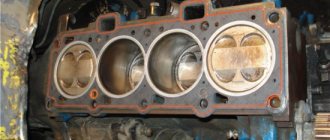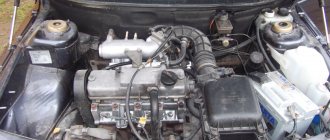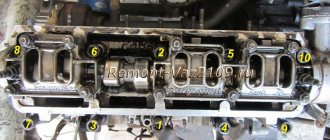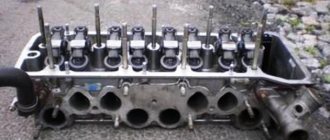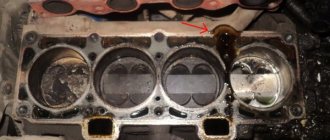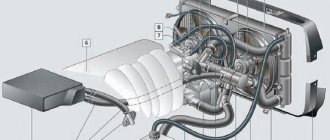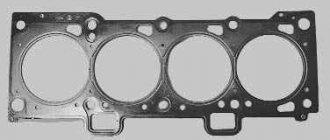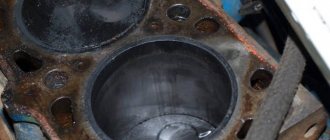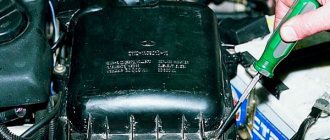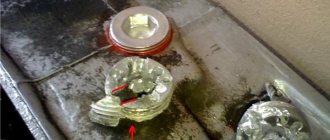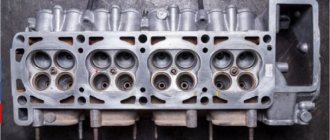The cylinder block can without a doubt be called the heart of an internal combustion engine. And the most important element of the cylinder block is the so-called. head. It has another short and most commonly used name: cylinder head. Although the cylinder head is a kind of cover for the cylinder block, there are many features in its design. We can’t help but talk about the materials used. Let's figure out what a cylinder head is, what its purpose is, what elements it consists of, and what malfunctions it may have.
The engine and what place the cylinder head occupies in it
In order to talk about the features of the cylinder head, it is worth briefly considering the operating principle of the internal combustion engine. The essence of engine operation is to convert the energy obtained from fuel combustion into mechanical work . Piston engines are used in cars, in which the reciprocating movement of the pistons using the so-called. The crank mechanism is already converted into rotation. Based on the features of modern internal combustion engines, the cylinder head must include the following elements:
- Places for injectors or spark plugs;
- Valve seats and their guides;
- Combustion chamber;
- Lubrication channels;
- A platform for mounting the gas distribution mechanism and its drive;
- Cooling jacket.
Separately, it is also worth highlighting the cylinder head cover, which acts as protection against mechanical influences, as well as a special gasket that ensures a tight fit of the cylinder head. The lid can be stamped metal or plastic. It has an oil filler neck and a plug. The block head itself can be made of two materials, which we will talk about a little later. In the meantime, we note that the material is extremely important, because how long the cylinder head can be used will depend on its characteristics.
In cars with single-row engines, the cylinder head is relatively simple and includes only one part. In more complex V-shaped engines, the head includes several parts for individual rows of cylinders. In both cases, the cylinder head is attached to the cylinder block with special studs and bolts. The procedure for installing the head is very complex and requires the use of a torque wrench, and also requires strict adherence to technology - the bolts are tightened with the force specified by the automaker and in a clear sequence (from central to outer). The aforementioned cylinder head gasket not only seals the sealing area, but also protects the power unit from internal pressure and oil leaks. By the way, this gasket is in fact disposable - if the cylinder head had to be removed, then it will have to be installed in place with a new gasket.
The design of the cylinder head and its functional purpose
The cylinder head, in accordance with its name, is located at the top of the engine. Essentially, this is a housing in which parts of the gas distribution mechanism (GDM) are mounted, which controls the intake of the air-fuel mixture into the cylinders and the exhaust gases. The head contains the upper parts of the combustion chambers. It has threaded holes for screwing in spark plugs and injectors, as well as holes for connecting the intake and exhaust manifolds.
Special channels (the so-called cooling jacket) are used to circulate the coolant. Lubrication is supplied through oil channels.
In addition, there are seats for valves with springs and drive elements. In the simplest case, there are two valves per cylinder (intake and exhaust), but there can be more. Additional intake valves make it possible to increase the total cross-sectional area and also reduce dynamic loads. And due to additional exhaust valves, heat dissipation can be improved.
The valve seat (seat), made of bronze, cast iron or heat-resistant steel, is pressed into the cylinder head body or can be made in the head itself.
Precision valve seating is ensured by guide bushings. The material for their manufacture can be cast iron, bronze, metal ceramics.
The valve head has a cone-shaped chamfer made at an angle of 30 or 45 degrees. This chamfer is the working surface of the valve and is adjacent to the chamfer of the valve seat. Both chamfers are carefully machined and ground to ensure a tight fit.
To reliably close the valve, a spring is used, which is made from alloy steel with subsequent special processing. The amount of pre-tightening significantly affects the operating parameters of the motor.
The camshaft controls the opening/closing of valves. It has two cams for each cylinder (one for the intake valve, one for the exhaust valve). Although other options are possible, including the presence of two camshafts, one of which controls the intake, the other controls the exhaust. In the engines of modern passenger cars, two camshafts are most often used, mounted on top, and the number of valves is 4 per cylinder.
Levers (rocker arms, rockers) or pushers in the form of short cylinders are used as a drive mechanism for controlling valves. In the latter version, the clearance in the drive is automatically adjusted using hydraulic compensators, which increases their reliability and extends their service life.
The lower surface of the cylinder head, which is adjacent to the cylinder block, is made smooth and carefully processed. To prevent antifreeze from entering the lubrication system or engine oil from entering the cooling system, as well as the penetration of these working fluids into the combustion chamber, a special gasket is installed between the head and the cylinder block during installation. It can be made of asbestos rubber composite material (paronite), copper or steel with polymer layers. This gasket provides a high degree of tightness, prevents the working fluids of the lubrication and cooling systems from mixing, and isolates the cylinders from each other.
The head is attached to the cylinder block using bolts or studs with nuts. The tightening of bolts must be approached very responsibly. It should be carried out in strict accordance with the car manufacturer's instructions according to a specific scheme, which may differ for different engines. It is imperative to use a torque wrench and observe the specified tightening torque, which should be indicated in the repair instructions.
Failure to comply with the procedure will lead to a violation of the tightness, breakdown of the cylinder head gasket, release of gases through the joint, decreased compression in the cylinders, and disruption of the isolation of the channels of the lubrication and cooling systems from each other. All this will manifest itself as unstable engine operation, loss of power, and excessive fuel consumption. At a minimum, you will have to change the gasket, engine oil and antifreeze with flushing of the systems. More serious troubles are also possible, including the need for serious engine repairs.
It must be remembered that the cylinder head gasket is not suitable for reinstallation. If the head is removed, the gasket must be replaced, regardless of its condition. The same applies to the fastening bolts.
The top of the cylinder head is closed with a protective cover (also called a valve cover) with a rubber seal. It can be made of sheet steel, aluminum or plastic. The cap usually has a filler neck for filling engine oil. Here you also need to observe certain tightening torques when tightening the fastening bolts and change the sealing rubber every time you open the cover.
Cylinder head materials
In engines with internal mixture formation, the cylinder head has holes for injectors, and in engines with external mixture formation, spark plugs. The head itself also has a valve mechanism that serves to admit the working fluid (fuel mixture) into the cylinders, as well as to release exhaust gases . All this means that the cylinder head is operated under conditions of high pressure, temperature, and also in direct contact with a chemically aggressive environment. As a result, high demands are placed on the materials from which the head will be made. Two materials have found use in the automotive industry:
- Aluminum . This is a fairly light and relatively cheap material. Aluminum alloys have high thermal conductivity. The walls of the aluminum heads have low thermal stress, which allows them to operate even at very high compression ratios without detonation. Engines with aluminum cylinder heads are lighter, have high economic and power indicators;
- Cast iron . Selects gray or alloy cast iron. Both alloys are distinguished by high density, which means large mass, but at the same time high strength and heat resistance. Cast iron is twice as heavy as aluminum and is susceptible to corrosion. Cast iron cylinder heads are most widely used in tractor-type vehicles, although cast iron parts are also used in passenger cars.
Spare parts for Mazda 2
Front right shock absorber
2 hatchback (DY) (01.03 - 07)
Spare parts for Hafei princip
Windshield washer fluid PRINCIP 5 sedan (06 - )
In some cases, they try to combine the high thermal conductivity of aluminum with the heat resistance of cast iron. For example, in air-cooled diesel engines In them, the base of the cylinder head and exhaust valves is made of cast iron, after which they are filled with aluminum alloy. Such engines have good heat dissipation, and the existing cylinder head is less deformed when alternating heating and cooling. In the case of a forced diesel engine operating under conditions of high thermal stress, the cylinder head is made using aluminum alloys.
Briefly about the types of cylinder heads
Depending on the overall design of the engine, cylinder head types are distinguished. There are four of them in total. They differ in design, as well as in the location of the combustion chambers, the type of timing belt and some other features. Regarding designs:
- One cylinder head in the so-called. in-line engines;
- Common heads for a number of cylinders in V-type (V-shaped) internal combustion engines;
- Separate cylinder heads in multi-cylinder in-line engines;
- Individual solutions: cylinder heads for single and multi-cylinder in-line internal combustion engines, V-shaped internal combustion engines and others.
Common 2-6 cylinder in-line engines use common heads. If the engine is V-shaped , then the cylinder head most likely covers one row of cylinders, although heads for each cylinder are also used, as in eight-cylinder engines . Individual cylinder heads can be seen in high-power diesel engines, as well as special power units, such as star and opposed two-cylinder units. If the engine is single-cylinder, then the head is strictly individual. The cylinder head is also classified according to the location of the combustion chambers. The following designs are possible:
- The camera is located directly in the head. With this design, the piston must have a flat bottom. There may be a displacer;
- The chamber is located both in the piston and in the cylinder head. Part of the combustion chamber is located at the bottom of the piston;
- The chamber is located directly in the piston. With this design, the cylinder head has a flat bottom surface, optionally with recesses for installing inclined valves.
But the classification does not end there either. Depending on the timing device and the presence of this mechanism in principle, the block heads may have different designs. For example:
- There is no timing belt. This is possible in single-cylinder, two-stroke, valveless, as well as multi-cylinder, lower-valve engines;
- Valves, rocker arms and other engine components are present. The camshaft is located at the bottom, the remaining engine components are mounted in the upper part of the cylinder head;
- Complete timing belt (camshaft, valves, drives, related elements). In this case, the parts are mounted in the upper part of the cylinder head.
The variety of timing belts is also determined by which engine they are designed for. There are heads for gasoline, gas, diesel units, for low-speed and forced engines, as well as air- or water-cooled . In general, the design of all heads is approximately the same, but in reality the heads are almost never interchangeable. Malfunctions of different types of heads are also similar.
What types of heads are there?
Cylinder heads are produced by casting from alloy cast iron or aluminum-based alloys. Aluminum alloy products are not as strong as cast iron, but they are lighter and less susceptible to corrosion, which is why they are used in the engines of most passenger cars.
To eliminate residual metal stress, the part is processed using a special technology. Then milling and drilling are done.
Depending on the engine configuration (cylinder arrangement, crankshaft and camshafts), it may have a different number of cylinder heads. In a single-row unit there is one head, in motors of another type, for example, V-shaped or W-shaped, there may be two of them. Large engines are usually equipped with separate heads for each cylinder.
The design of the cylinder head also varies depending on the number and location of camshafts. Camshafts can be mounted in an additional head compartment, or they can be installed in the cylinder block.
Other design features are possible, which depend on the number and location of cylinders and valves, the shape and volume of combustion chambers, the location of spark plugs or injectors.
In engines with lower valves, the head has a much simpler design. It only contains antifreeze circulation channels, seats for spark plugs and fastening elements. However, such units have low efficiency and have not been used in the automotive industry for a long time, although they can still be found in special equipment.
Principle of operation
In short, the cylinder head is responsible for forming the combustion chamber, supplying the combustible mixture to the chamber and further removing exhaust gases. In words everything is quite simple, but let's look at everything in detail. So, when the engine starts, the cylinder head comes into operation. Here's what happens:
- The camshaft pushes a rod, which then puts pressure on the hydraulic compensator and rocker arm;
- The rocker puts pressure on the valve, which immediately opens. Valves in diesel internal combustion engines are somewhat different from their gasoline “counterparts” in functionality;
- The valve ends up in the combustion chamber, where the mixture is ignited by the spark plug;
- Exhaust gases are discharged into the exhaust manifold;
- The spring returns the valve to its original position. The cycle repeats.
In diesel engines, the mixture is ignited by compression, so the key parameter is the synchronization of fuel injection by a special diesel injector with the opening of the intake valve. In the case of the cylinder head of both gasoline and diesel engines, the tightness of the gas joint - if it loses its tightness, the fuel will not burn completely, and the engine will be more difficult to start. Also, with loss of tightness, one can note increased noise of the engine and its accelerated wear during operation.
Briefly about cylinder head gaskets
Since we are talking about tightness, let’s stop and consider this parameter. When installing the head to the BC, it is necessary to strictly follow the technology, which we briefly mentioned above. Before installation, it is important to select the correct gasket, which will make the connection tight and more reliable. Technologies do not stand still, and today on the automotive components market there are as many as three varieties of cylinder head gaskets. The key is the gasket material:
- Metal . The metal gasket (sheet copper + steel) boasts durability and high strength. Loads are evenly distributed in it, and in the case of specific BCs, zones with additional elements for compaction are provided. This is a classic “disposable” gasket;
- Asbestos . Despite the fact that the main material of such a gasket is asbestos, it also contains metal elements. Asbestos is resilient and has impressive fire resistance. The material loses its properties during long-term use, and is also sensitive to both vibrations and sudden temperature changes;
- Composite materials . Composite gaskets are often called non-asbestos gaskets. Materials: synthetic fiber and rubber. Such gaskets are resilient, elastic, durable, and are also not afraid of temperature changes, corrosion and have high electrical insulating properties. In addition, the production of asbestos-free gaskets does not have a serious impact on the environment, which the technology for producing asbestos gaskets cannot boast of.
At the moment, non-asbestos cylinder head gaskets are considered the best. Their only drawback is their high price, and in some cases low availability in local auto parts stores. But don’t think that even the best gasket cannot fail. The service life is affected by compliance with the head installation technology, and the normal operation of the pump, thermostat, the absence of scale in the cooling system, as well as refueling the car with high-quality fuel and correct adjustment of the unit.
Cylinder head malfunctions
In fact, the cylinder head is a large metal block of complex shape. The main defect of such a block is the appearance of cracks . Since the head includes many related parts and elements, usually when experts talk about cylinder head malfunctions, they mean one of the following:
- Failure of spark plug threads;
- Breakage of springs, rockers, valves, compensators;
- Loss of tightness due to a defective cylinder head gasket;
- The appearance of cracks on the cylinder head itself;
- Wear of beds under the camshaft;
- Valve seat falling out;
- Exhaust gases enter the cooling system through a hole formed in the lower part of the cylinder head.
As for defects in the cylinder head itself (cracks, holes), they do not always indicate the need to replace the entire head. For example, if a crack appears between the cooling jacket and the combustion chamber, repair is often not practical. In the vast majority of cases, cracks outside the gas can be welded. Wear on the camshaft beds can be eliminated by restoring them with bronze bushings .
If you do not contact a specialist in a timely manner, damage to the cylinder head can become so serious that the entire unit begins to quickly collapse and lose all repairability. , valves fail . As practice has shown, when the valve is not completely closed, the piston hits the valve plate, as a result of which the valve is deformed and its tight fit to the seat is disrupted. Further, defects appear in the cylinder head, piston group and valves. Over time, one of the piston groups completely fails and the engine begins to operate in abnormal mode. The easiest way to solve a problem is in the first stages of its occurrence. Please note that even after repair, you need to “listen” to the engine - if it is running unstable, you need to contact a specialist as soon as possible. If the repair was made by an unqualified specialist, grinding in the parts will not solve the problem, no matter what the specialist claims.
Please note that regardless of the complexity of the cylinder head repair, the unit must be carefully polished and, optionally, milled. Grinding of the mating plane of the head is mandatory. If a qualified specialist undertakes restoration and repair, he will most likely be able to restore the part to almost its original condition. All the work will take a lot of time. Also, car enthusiasts should not forget that when purchasing a new cylinder head gasket, they should give preference to products from well-known manufacturers or originals.
Operating rules, possible malfunctions and problems
The cylinder head is a rather vulnerable functional unit, exposed to a complex of negative factors. Therefore, the following are not excluded and quite probable:
- Breakdown of threaded connections (for spark plugs or studs), cracks on the outside of the housing. Cracks are formed due to improper tightening of fasteners, and thread defects most often turn out to be hidden manufacturing defects.
- Curvature of the joint plane, surface corrosion and loosening of fasteners. They arise due to prolonged operation, engine overheating, and poor-quality coolant.
- Formation of interseat cracks and loss of valve seats. Reasons: low-quality fuel, expiring equipment life, poorly adjusted ignition.
- Wear of the pushrod group and camshaft.
- Failure of valve guides. The reason is significant mileage, substandard lubrication.
In case of gas breakthrough, the head is most often milled. If the spark plug thread breaks, a “screw-in” is installed, and the fastening system must be replaced.
The spread of inter-seat cracks contributes to the leakage of exhaust gases into the cooling jacket and jamming of the pistons. In this case, the head can be replaced; at least the cracks can be welded in compliance with the technology.
A drop in oil pressure indicates problems with the camshaft. The diameter of the camshaft beds is restored by inserting duralumin or brass bushings (as a rule, the old camshaft with milling teeth is used as a reamer).
In addition, significant corrosion and damage from detonation make repairs impossible. The fallen seat, by cooling in liquid nitrogen vapor, is replaced with a new one, or with a similar one drilled from another head.
Conclusion
The cylinder head is a seemingly simple component of an internal combustion engine, in which there is simply nothing to break. Due to the complexity of modern engines and the fact that they are operated in harsh conditions, you cannot be sure that problems with the cylinder head will never arise during the entire period of operation of the vehicle. Of course, in most cases, only replacing the gasket is required, but it is important for the car enthusiast to remember that any change in the nature of the engine’s operation may indicate the appearance of far-reaching problems. Remember that abnormal engine operation, increased oil and fuel consumption, decreased acoustic comfort and strange behavior of the unit at different speeds indicate the need for diagnostics.
In the article:
- What types of heads are there?
- The design of the cylinder head and its functional purpose
- About repair and replacement
A modern internal combustion engine is a very complex unit, which includes a large number of components and parts. The key component of the internal combustion engine is the cylinder head (cylinder head). The cylinder head, or simply the head, serves as a kind of cover that covers the top of the engine cylinders. However, this is far from the only functional purpose of the head. The cylinder head has a rather complex structure, and its condition is critical for the normal operation of the engine. Every car enthusiast should understand the structure of the head and understand how this element functions.
